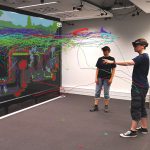MIRIA
A Mixed-Reality Interaction Analysis Toolkit
MIRIA, short for Mixed Reality Interaction Analysis Toolkit, is a system for the analysis of spatial interaction data in mixed reality. MIRIA specifically supports in-situ data analysis by using situated, immersive visualizations. I wrote MIRIA in C# for the Unity engine, targeting Microsoft’s HoloLens series of AR headsets.
MIRIA can import data, such as motion tracking data, from CSV files and visualize it in several different 2D and 3D visualizations, most importantly as 3D trajectories in space. MIRIA supports multiple co-located users and doesn’t need an additional server or tracking system, making it useful for usage in a wide range of environments.




For more details about MIRIA, please take a look at the main project website or check out the git repository! Additionally, if you would like to cite MIRIA in your research, please cite our CHI ‘21 paper.
References
2021
-
 In Proceedings of the 2021 CHI Conference on Human Factors in Computing Systems, May 2021
In Proceedings of the 2021 CHI Conference on Human Factors in Computing Systems, May 2021